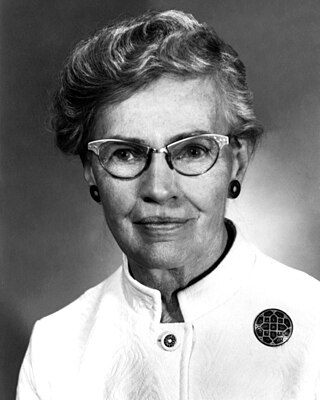
The American Astronomical Society is an American society of professional astronomers and other interested individuals, headquartered in Washington, DC. The primary objective of the AAS is to promote the advancement of astronomy and closely related branches of science, while the secondary purpose includes enhancing astronomy education and providing a political voice for its members through lobbying and grassroots activities. Its current mission is to enhance and share humanity's scientific understanding of the universe as a diverse and inclusive astronomical community.

Eleanor Margaret Burbidge, FRS (née Peachey; 12 August 1919 – 5 April 2020) was a British-American observational astronomer and astrophysicist. In the 1950s, she was one of the founders of stellar nucleosynthesis and was first author of the influential B2FH paper. During the 1960s and 1970s she worked on galaxy rotation curves and quasars, discovering the most distant astronomical object then known. In the 1980s and 1990s she helped develop and utilise the Faint Object Spectrograph on the Hubble Space Telescope. Burbidge was also well known for her work opposing discrimination against women in astronomy.

William Alfred Fowler (August 9, 1911 – March 14, 1995) was an American nuclear physicist, later astrophysicist, who, with Subrahmanyan Chandrasekhar, was awarded the 1983 Nobel Prize in Physics. He is known for his theoretical and experimental research into nuclear reactions within stars and the energy elements produced in the process and was one of the authors of the influential B2FH paper.

Willem de Sitter was a Dutch mathematician, physicist, and astronomer.

Charlotte Emma Moore Sitterly was an American astronomer. She is known for her extensive spectroscopic studies of the Sun and chemical elements. Her tables of data are known for their reliability and are still used regularly.

The Astronomical Society of the Pacific (ASP) is an American scientific and educational organization, founded in San Francisco on February 7, 1889, immediately following the solar eclipse of January 1, 1889. Its name derives from its origins on the Pacific Coast, but today it has members all over the country and the world. It has the legal status of a nonprofit organization.
The Helen B. Warner Prize for Astronomy is awarded annually by the American Astronomical Society to a young astronomer for a significant contribution to observational or theoretical astronomy.
Willem Jacob Luyten was a Dutch-American astronomer.

Geoffrey Ronald Burbidge (24 September 1925 – 26 January 2010) was an English astronomy professor and theoretical astrophysicist, most recently at the University of California, San Diego. He was married to astrophysicist Margaret Burbidge and was the second author of the influential B2FH paper which she led.
The Canada Gairdner International Award is given annually by the Gairdner Foundation at a special dinner to five individuals for outstanding discoveries or contributions to medical science. Receipt of the Gairdner is traditionally considered a precursor to winning the Nobel Prize in Medicine; as of 2020, 98 Nobel Prizes have been awarded to prior Gairdner recipients.
The Gordon Myers Amateur Achievement Award, known until 2018 as the Amateur Achievement Award of the Astronomical Society of the Pacific, is one of nine annual astronomical awards managed by the Astronomical Society of the Pacific. It recognizes "significant contributions to astronomy or amateur astronomy by those not employed in the field of astronomy in a professional capacity." The contributions can be done in the fields of both observational astronomy or astronomical technologies. The award has been given to amateur astronomers from various countries since 1979 and has become one of the most geographically diverse astronomical awards.

The Prix Jules Janssen is the highest award of the Société astronomique de France (SAF), the French astronomical society.

The John Price Wetherill Medal was an award of the Franklin Institute. It was established with a bequest given by the family of John Price Wetherill (1844–1906) on April 3, 1917. On June 10, 1925, the Board of Managers voted to create a silver medal, to be awarded for "discovery or invention in the physical sciences" or "new and important combinations of principles or methods already known". The legend on the first medal read: "for discovery, invention, or development in the physical sciences". The John Price Wetherill Medal was last awarded in 1997. As of 1998 all of the endowed medals previously awarded by the Franklin Institute were reorganized as the Benjamin Franklin Medals.








